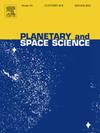He+ ions in the vicinity of mercury observed by the MESSENGER and BepiColombo spacecraft
IF 1.7
4区 物理与天体物理
Q3 ASTRONOMY & ASTROPHYSICS
引用次数: 0
Abstract
The MErcury Surface, Space ENvironment, GEochemistry, and Ranging (MESSENGER) spacecraft was launched in 2004, and between March 2011 and April 2015 it was the first spacecraft in orbit around Mercury. The Fast Imaging Plasma Spectrometer (FIPS) instrument on board MESSENGER measured the ion composition in the vicinity of Mercury and in the inner solar system.
We aim to determine the origin of He ions in the inner solar system and in the environment of Mercury, continuing earlier work by Gershman et al., (2013).
We have analyzed measurements of He and He ions made by the FIPS instrument during the interplanetary cruise phase of MESSENGER and its entire orbital mission at Mercury. We determined the spatial distributions of He ions in the regions sampled by MESSENGER during that period and compare the spectra to a similar observation by the Mass Spectrum Analyzer instrument which is part of the Mercury Plasma Particle Experiment (MPPE-MSA) onboard BepiColombo. We consider two possible sources of He: (1) interstellar neutral helium ionized close to Mercury and (2) solar He ions converted close to or at the surface of Mercury. We also compare the observed densities with a simple model of the ionization of the interstellar helium flow.
The FIPS data show a continuous evolution of the He energy spectra from solar wind towards Mercury - changing from a shape typical for pick-up ions to a thermalized spectrum. This could mean that interstellar He is concentrated at Mercury by increased electron impact ionization close to the planet. We find a remarkably similar high mean ratio of He/He ions in the upstream solar wind and in the inner magnetosphere, while the ratio is reduced in the magnetosheath.
Outside Mercury’s magnetosphere the source of He ions is interstellar helium, while inside the planet’s magnetosheath and the magnetosphere both interstellar helium and solar wind helium may be of similar magnitude. The observed median upstream He densities are in good quantitative agreement with a simple model — though the existence of an upstream density crescent cannot yet be confirmed.
信使号和比皮可伦坡号航天器在水星附近观测到的He+离子
水星表面、空间环境、地球化学和测距(信使号)航天器于2004年发射,在2011年3月至2015年4月期间,它是第一个进入水星轨道的航天器。信使号上搭载的快速成像等离子体光谱仪(FIPS)测量了水星附近和太阳系内部的离子组成。我们的目标是确定太阳系内部和水星环境中He+离子的起源,继续Gershman等人(2013)的早期工作。我们分析了FIPS仪器在信使号的行星际巡航阶段和水星的整个轨道任务期间对He+和He2+离子的测量结果。我们确定了信使号在这段时间内采样区域的He+离子的空间分布,并将光谱与BepiColombo上的汞等离子体粒子实验(MPPE-MSA)的质谱分析仪的类似观测结果进行了比较。我们考虑了两种可能的He+来源:(1)星际中性氦在水星附近电离,(2)太阳He2+离子在水星附近或水星表面转化。我们还将观测到的密度与星际氦流电离的简单模型进行了比较。FIPS数据显示了从太阳风到水星的He+能量光谱的连续演变——从典型的吸收离子形状转变为热化光谱。这可能意味着星际间的He+聚集在水星上,是因为靠近水星的地方电子碰撞电离增加了。我们发现在太阳风上游和内磁层中He+/He2+离子的平均比值非常相似,而在磁鞘中该比值降低。在水星的磁层之外,氦离子的来源是星际氦,而在水星的磁层和磁层内部,星际氦和太阳风氦的大小可能相似。观测到的上游He+密度中值与一个简单的模型在定量上是一致的——尽管上游密度月牙的存在还不能被证实。
本文章由计算机程序翻译,如有差异,请以英文原文为准。
求助全文
约1分钟内获得全文
求助全文
来源期刊

Planetary and Space Science
地学天文-天文与天体物理
CiteScore
5.40
自引率
4.20%
发文量
126
审稿时长
15 weeks
期刊介绍:
Planetary and Space Science publishes original articles as well as short communications (letters). Ground-based and space-borne instrumentation and laboratory simulation of solar system processes are included. The following fields of planetary and solar system research are covered:
• Celestial mechanics, including dynamical evolution of the solar system, gravitational captures and resonances, relativistic effects, tracking and dynamics
• Cosmochemistry and origin, including all aspects of the formation and initial physical and chemical evolution of the solar system
• Terrestrial planets and satellites, including the physics of the interiors, geology and morphology of the surfaces, tectonics, mineralogy and dating
• Outer planets and satellites, including formation and evolution, remote sensing at all wavelengths and in situ measurements
• Planetary atmospheres, including formation and evolution, circulation and meteorology, boundary layers, remote sensing and laboratory simulation
• Planetary magnetospheres and ionospheres, including origin of magnetic fields, magnetospheric plasma and radiation belts, and their interaction with the sun, the solar wind and satellites
• Small bodies, dust and rings, including asteroids, comets and zodiacal light and their interaction with the solar radiation and the solar wind
• Exobiology, including origin of life, detection of planetary ecosystems and pre-biological phenomena in the solar system and laboratory simulations
• Extrasolar systems, including the detection and/or the detectability of exoplanets and planetary systems, their formation and evolution, the physical and chemical properties of the exoplanets
• History of planetary and space research
 求助内容:
求助内容: 应助结果提醒方式:
应助结果提醒方式:


